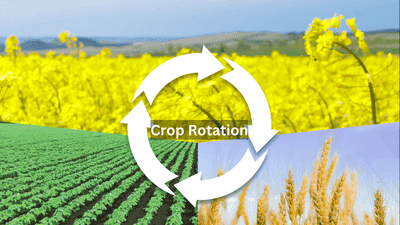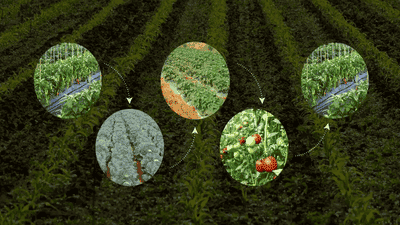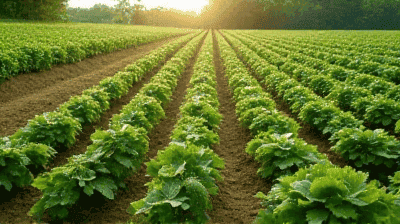
In the quest for sustainable agriculture, one of the oldest yet most effective practices is crop rotation. This technique, which dates back thousands of years, involves alternating the types of crops grown in a specific area across different growing seasons. Crop rotation is fundamental to maintaining healthy soils, managing pests and diseases, and enhancing overall agricultural productivity. In an era increasingly focused on reducing chemical inputs and enhancing environmental sustainability, understanding the science behind crop rotation becomes crucial.
Crop rotation is the agricultural practice of growing different types of crops in the same area across a sequence of seasons or years. By alternating crops, farmers can improve soil health, reduce pest and disease pressures, and enhance nutrient availability.
Humans have utilized crop rotation for millennia. Ancient civilizations, such as the Romans and the Chinese, recognized the benefits of alternating crops to maintain soil fertility. Over time, the practice evolved and became a mainstream agricultural technique, particularly as monoculture farming became prevalent in the modern era.
Crop rotation can take many forms, depending on the specific goals and conditions of the farming system. Some common rotation systems include:
Simple Rotation: Alternating two or three different crops in a specific sequence. For example, planting corn one year and soybeans the next.
Diverse Rotation: Incorporating a wider variety of crops in the rotation, often including legumes, grains, and cover crops. This promotes biodiversity and enhances soil health.
Perennial Crop Rotation: Including perennial species in the rotation cycle, which can contribute to long-term soil stability and health.

One of the primary benefits of crop rotation is improved nutrient management. Different crops have varying nutrient requirements and roots that access different soil layers. For instance, deep-rooted crops can explore nutrients and water in deeper soil layers that shallow-rooted crops might miss. By alternating crops, farmers can help maintain a balanced nutrient profile in the soil.
Different crops contribute various organic matter and root structures to the soil. For example, small-seeded crops create less soil disturbance, while deep-rooted plants can improve soil structure by breaking compacted layers. This diverse root system enhances soil aeration and water infiltration, leading to improved soil health and productivity.
Crop rotation can help break the life cycles of pests and pathogens. Many pests are specific to certain crops, which means growing the same crop continuously can lead to an accumulation of pests and diseases in the soil. By rotating crops, farmers can disrupt these cycles and reduce pest populations.
Diverse rotations enhance ecosystem resilience by promoting beneficial insects, microorganisms, and other organisms that contribute to pest control. By supporting a variety of species, farmers can foster natural pest management processes, reducing the reliance on chemical inputs.
Weeds compete with crops for resources and can significantly impact agricultural productivity. Crop rotation can play a vital role in managing weed populations by disrupting their growth cycles and preventing the establishment of persistent weed species.
Varied Growth Habits: Different crops have varying growth habits, which can outcompete specific weeds. For example, tall crops like corn may shade out shorter weeds, while densely planted crops can crowd out unwanted plants.
Allelopathy: Some crops, such as certain varieties of barley or rye, release chemicals into the soil that inhibit the growth of specific weed species, adding another layer of natural weed management.
Crop rotation contributes to nutrient cycling, where different crops contribute to the overall fertility of the soil. By planting legumes and incorporating organic matter from diverse crops, farmers can improve the soil’s nutrient content—reducing the need for synthetic fertilizers.
Research shows that farms using crop rotation often achieve higher yields than those relying on monoculture practices. The improved health and structure of the soil contribute to more robust plant growth and ultimately higher harvests.
By reducing the reliance on chemical fertilizers and pesticides, crop rotation helps minimize agricultural runoff, protecting surrounding ecosystems and water sources. This practice contributes to sustainable land use and promotes biodiversity.
Crop rotation can lead to improved economic outcomes for farmers. Diverse crop systems can help stabilize and increase income by spreading risk across multiple crops and reducing costs associated with chemical inputs.

Before implementing a crop rotation plan, farmers should assess their soil health, pest populations, crop history, and market demands. Understanding these factors will help determine the most suitable crops for rotation.
Farmers should consider the following principles when designing a crop rotation plan:
Diversity: Include a variety of crops, including legumes, grains, and cover crops, to promote soil health and pest management.
Sequence: Develop a logical sequence based on crop families. Avoid planting crops from the same family consecutively to reduce disease pressures.
Timing: Consider planting and harvesting dates, as well as the growing conditions for each crop, to optimize yield and minimize competition.
Maintaining detailed records of crop rotations is essential for assessing outcomes and making informed decisions. Tracking yields, pest populations, and soil health indicators will help refine rotation practices over time.
Planting cover crops during the off-season can further enhance the benefits of crop rotation. Cover crops protect the soil from erosion, improve soil health, and can be terminated before planting the primary crop to add organic matter.
Agricultural systems are dynamic, and farms must adapt their practices over time. Farmers should stay informed about new research, technologies, and emerging challenges to continually refine their crop rotation strategies.
Many organic vegetable farms successfully implement crop rotation as a cornerstone of their production systems. By alternating crops such as tomatoes, carrots, and leafy greens, these farms effectively manage pests while enhancing soil health. The integration of cover cropping during off-seasons further enriches their soil and contributes to increased biodiversity.
In some regions, farmers have adopted rotation systems that alternate grains like corn and wheat with legumes such as soybeans or peas. This practice not only promotes soil fertility through nitrogen fixation but also helps break disease cycles associated with both crop types.
Mixed farms that integrate livestock with crops often utilize crop rotation to manage soil health and nutrient cycling effectively. After harvesting crops, farmers may plant forage or cover crops that sheep or cattle graze, thereby returning nutrients to the soil while controlling weeds.

Many farmers, particularly those traditionally trained in monoculture practices, may lack knowledge of effective crop rotation strategies. Education and training are crucial to empower farmers to adopt these sustainable practices.
Farmers must consider market preferences and demand when planning crop rotation. Growing diverse crops may require new marketing strategies and adapting to fluctuating market conditions.
Crop rotation practices should be tailored to local environmental conditions, climate, and soil types. Farmers need to evaluate their specific contexts to develop rotation plans that yield positive results.
Transitioning to crop rotation may necessitate changes in infrastructure and the type of machinery used on the farm. Farmers should assess whether additional resources or adjustments will be needed to accommodate diverse crops.
Government policies that support sustainable agricultural practices, including crop rotation, are essential for promoting broader adoption. Incentives for organic farming, conservation programs, and educational outreach can help farmers make the transition.
Research institutions and universities can play a pivotal role in advancing crop rotation practices through innovation and the development of new technologies. Ongoing research can identify effective rotations tailored to various environments and crops.
Farmers can benefit from collaborative networks that share best practices and experiences in crop rotation. Community-supported agriculture (CSA) programs and local farming organizations can foster knowledge exchange and provide support for farmers exploring diverse agricultural practices.
Combining crop rotation with other sustainable agricultural practices, such as agroecology, cover cropping, and integrated pest management, can enhance overall farm resilience and productivity. A holistic approach to farming will be essential to meet the challenges of climate change and food security.
Crop rotation is a time-tested and scientifically supported practice that offers numerous benefits for soil health and sustainable agriculture. By fostering biodiversity, improving soil fertility, and managing pests and diseases naturally, crop rotation serves as an essential tool for modern organic farmers and those seeking to transition to more sustainable practices.
In a world increasingly focused on minimizing chemical inputs and enhancing ecosystem resilience, embracing the science behind crop rotation can lead to healthier soils, increased agricultural productivity, and more sustainable food systems. As farmers continue to innovate and adapt, crop rotation will undeniably remain a cornerstone of sustainable agriculture for future generations.